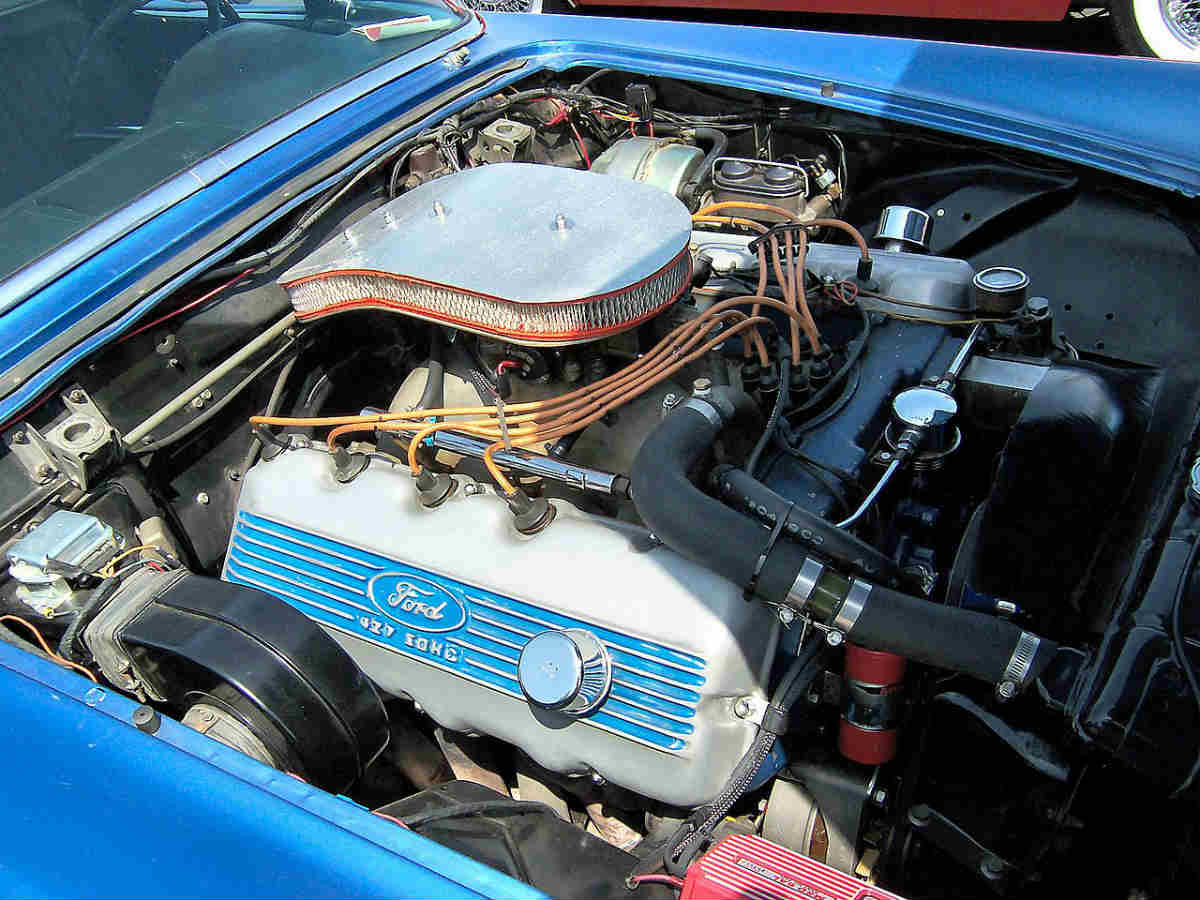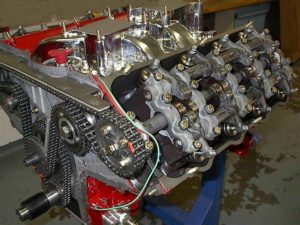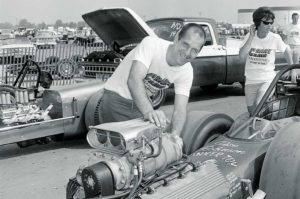The Cammer – Ford’s Answer to the Hemi
 In the heyday of the muscle car, very few of the racing engines coming out of the Motor City rivaled Ford’s 427 CID SOHC V8 engine, otherwise known as the “Cammer.” When equipped with dual four-barrel carburetors, the legendary powerhouse generated a prodigious 657 horsepower. Even when a single four-barrel carburetor was employed, the engine could still generate 616 horsepower. Therefore, it should come as no surprise that this big, powerful engine often appears on lists of the top ten engines of all time.Opens a new window
In the heyday of the muscle car, very few of the racing engines coming out of the Motor City rivaled Ford’s 427 CID SOHC V8 engine, otherwise known as the “Cammer.” When equipped with dual four-barrel carburetors, the legendary powerhouse generated a prodigious 657 horsepower. Even when a single four-barrel carburetor was employed, the engine could still generate 616 horsepower. Therefore, it should come as no surprise that this big, powerful engine often appears on lists of the top ten engines of all time.Opens a new window
The development of the Cammer was inspired by Richard Petty’s stunning upset in the 1964 Daytona 500Opens a new window in a Plymouth powered by Chrysler’s 426 Hemi. The sudden emergence of the Hemi engine shook things up in the Ford racing community. Ford’s 427 Hi-riser engine had once reigned supreme, winning race after race before the Petty upset.
Concept to Reality in Just 3 Months
Ford was quick to respond to the new threat posed by Chrysler’s powerful Hemi power plant. Ford’s modification of the Hi-riser engine proceeded from the drawing board to reality in less than three months.
Ford then went to NASCAR seeking approval for its new single overhead cam design. According to a February 23, 1964, article in the Daytona Beach Morning Journal, NASCAR head Bill France nixed the idea. Some speculated that he saw overhead cam engines as better suited to European racecourses. Clearly, he did not want them America’s Grand National stock car circuit.
The engine had quickly generated its share of controversy. In fact, NASCAR’s pre-emptive strike was decisive. The organization banned the engine before it ever appeared in a NASCAR event.
Persistent Efforts to Garner Approval
For a time, Ford did not give up hope that the Cammer would eventually find its way out on the circuit. The Detroit automaker would go on to display a 1964 Ford Galaxie before the 1964 Indy 500, hoping for positive reviews from the press. Ultimately, Ford hoped that positive publicity would lead to an eventual NASCAR reversal, but this never happened. Instead, in October of that year, NASCAR moved to eliminate both the Ford 427 SOHC Cammer and the Chrysler 426 Hemi from the Grand National circuit, derisively referring to both as “special racing engines.”
Chrysler officials viewed the decision with contempt, and the automaker actually pulled out of NASCAR competition in protest. Ford, however, continued to compete with its traditional pushrod engines.
Meanwhile, the Ford engine was the subject of a detailed review in the January 1965 issue of Hot Rod magazineOpens a new window. It also graced the cover of that particular issue. Much of the material for the article derived from a paper, SAE 650497, presented by the lead engineers working on the 427 SOHC project.
Still, in December 1965, NASCAR renewed its ban of the Cammer for the 1966 season. The USAC staked out a similar position. Then, in April 1966, NASCAR appeared to reverse itself, as it allowed the use of the single-carb Cammer in full-size Galaxies. However, with a weight handicap of 4400 pounds, the setup was not competitive with Chrysler Hemis that came in at over 400 pounds less. The Ford Motor Company rejected this NASCAR offer, and it set its sights on promoting the Cammer for drag racing. The Cammer still appears in vintage drag racing events even today.
Ford’s overhead cam design had invaded the world of the pushrod V8s. Chrysler cried foul and won. The Cammer never appeared in regular-production Fords either. Although the powerful V8 was never featured in a showroom model, Ford did use the innovative power plant in some of its 1964-67 Galaxie prototypes. The Cammer was also an important predecessor to the Ford production SOHC and DOHC engines that followed in the years that followed.
427 SOHC Design Features
 Although the 427 SOHC engine eventually became the stuff of legend, it represented a quick and reasonably simple modification of the FE engine. Ford only invested modest sums in the project while the real money went into development of an Indy power plant, a pricey DOHC design based on Ford’s small-block V8.
Although the 427 SOHC engine eventually became the stuff of legend, it represented a quick and reasonably simple modification of the FE engine. Ford only invested modest sums in the project while the real money went into development of an Indy power plant, a pricey DOHC design based on Ford’s small-block V8.
The Cammer represented an evolution of the Hi-riser short block engine. It featured hemi-head pistons and a forged steel crankshaft. The machined cylinder heads were redesigned, and a single overhead camshaft was positioned above each of them. With the camshafts positioned above the cylinder heads, the pushrods are eliminated. The design allows for straighter and larger intake ports. Inside the engine, the camshaft was replaced by an idler shaft that operated the oil pump and the distributor. Oil passages were sealed off by steel bushings.
The new creation originally featured a lengthy timing chain almost 7 feet long. Racing teams had to adjust the cam timing from four to eight degrees to successfully cope with the inevitable slack in such a long chain drive. The chain also required the use of cams that essentially mirrored each other. Eventually, the timing chain was replaced by a gear drive system. With the addition of an extra gear on the left bank, right-hand camshafts could now be used with both banks.
The Cammer in Drag Racing
 The Cammer would be a successful drag racing solution only if a number of sticky problems could be resolved. For example, the gear drive system that replaced the timing chain was the result of a collaborative effort by Pete Robinson, Harvey Crane and P&S Machine.
The Cammer would be a successful drag racing solution only if a number of sticky problems could be resolved. For example, the gear drive system that replaced the timing chain was the result of a collaborative effort by Pete Robinson, Harvey Crane and P&S Machine.
Eventually, the Cammer achieved real success as a drag racing engineOpens a new window, and derivations powered a number of Top Fuel Dragsters of the day. For example, Ed Pink and driver Tom McEwen used a Cammer in an AA/Fuel Dragster at the U.S. Nationals in 1967. Ford also worked out Cammer deals with nitro racers like Connie Kallita and Pete Robinson. Don Nicholson used the Cammer in 1966-67 in flip-top Comet funny cars.
Scarce Engine Today
Given the fact that Cammers are really scarce and expensive nowadays, it is difficult to imagine that they were OE surplus 45 years ago. Back then, a new Cammer crate engine sold for about $2,300.
The 427 SOHC engine may have been part of the FE engine lineup, but it differed in that it was essentially a hand-built racing engine. In terms of NASCAR-sanctioned events, it would forever remain a racing engine in search of a race. Should the Cammer ever become the subject of a friendly debate, take bets on whether it ever appeared in a NASCAR race. Just make sure to bet that it never did, because that’s a fact.






Very good story on the 427. There is a lot of lost history regarding many of Ford’s early high performance engines. It would appear the 427 was the best of the best for Ford.
I Love The Fact That It Was Never Used And Was A Specialty Engine , Historically Significantly
Proven Winner
I am a big fan of the Ford 427 SOHC engine. I bought two of them NOS many years ago. I installed one in a Cobra of mine in 1991 and have enjoyed it ever since. I had a few issues with it, but I must say that it has been good to me……in spite of the erratic Eonics camshafts and the 12.5 to 1 compression. I continue to have respect for FoMoCo with their current endeavour with the latest DOHC motors. Had cooler heads prevailed in 1964-1965; by Nascar and USAC…..by implementing more reasonable restrictions on the big three……like reducing displacement ….reduce fuel octane available….or a change in camshaft specs……they could have allowed the overhead cam engines to compete at a level deemed safe by the racing community. Everyone except Chevrolet ( who managed to get their non production rat motor to compete while being outside the allowable rules….for three years ) had a version of an OHC engine in prototype or advanced design. Had these engines been allowed……it would have been the death of the pushrod engine and we would all be driving OHC cars and trucks for the last fifty years……like Europe and Asia.
Warren Schettler
Great & informative article. Brought back some nostalgic memories (even though I was never a hot rod owner, just a wannabe & custom model car builder & fan), and I learned some things I didn’t know. Thanks.
They were unreliable… blew up all the time… this is why they are gone.
You do know the reason they blew up is because the block was rated at 750 hp and they boosted them all the way up to over 2500 hp in drag racing applications…
@JamesM. You don’t know much about the FORD 427 Cammer do you? lol. No one could touch Mickey Thompsons 427 Cammer Mach 1 Funny Car in 1969 genius! And Dyno Don, Fast Eddie Schartman, Sneaky Pete Robinson, Connie Kalitta, Jack Chrisman, (just to name a few), were quite successful running the 427 Cammer…. The 427 Cammer was originally built to compete in NASCAR. But the little girls at FIAT chrysler, protested the 427 Cammer, prompting France to ban the engine for use in NASCAR. So FORD decided to try the 427 Cammers in drag racing. Within 2-3 years of development in drag racing, the 427 Cammers were smoking the chrysler FIATS and chivies. So much so, that FIAT chrysler and GM little girl drag racers demanded the FORD 427 Cammer to be outlawed in NHRA in 1970. And it was. Precisely why FORD dropped the 427 Cammer program. Had the FORD 427 Cammer engine been allowed to continue on in drag racing, and be developed, it would be dominate in drag racing today. Ed Pink said that himself! Fans are finally getting tired of the politics in drag racing. Which is precisely why drag racing fan attendance is dying. The majority of drag racing fans don’t want to see only FIAT chryslers and GMs.
I have run a Cammer in a streetrod down here in Australia since 1981 apart from an excess of compression for the fuel available it ha served me very well and is a pleasant change from those Belly Button motors seen SO often. Just rebuilt it with appropriate compression and some milder cams.